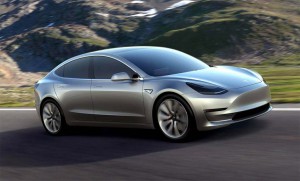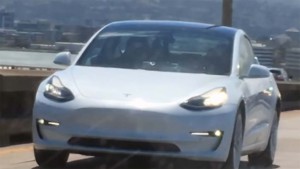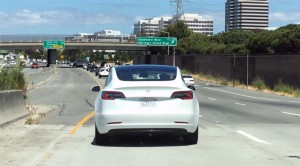For many owners, one of the most appealing features of the Tesla Model S is its neck-snapping acceleration – with the optional Ludicrous Mode the sedan capable of launching from 0 to 60 in around 2.8 seconds.
While the new Tesla Model 3 will nearly match the range of some versions of the bigger sedan, don’t expect to see it come close when it comes to performance. What appear to be official Tesla figures indicate the new battery-electric vehicle, or BEV, will need about 5.6 seconds to nudge 60. That’s faster than the rival Chevrolet Bolt EV, but just barely, and more in line with what some comparably-sized gas-powered vehicles can deliver.
Early EVs were battery-powered stone ponies, barely able to get out of their own way, the little Mitsubishi MiEV, for example, needing a full 13 seconds to get to 60. That’s a key reason, industry analysts suggest, that demand for those first-generation electrics was so poor. By boosting range and performance, however, buyers finally to be sitting up and taking notice.
When it comes to range, it appears Tesla will do slightly better than the 200 miles it originally promised, the new data suggesting it will get 215 miles on a charge. That’s less than the 238 miles that the EPA gives the Chevy Bolt, however.
That said, range and performance numbers are for the base version of the Model S, which will carry a starting price of around $35,000 before factoring in delivery fees and any applicable state and federal incentives. The Bolt, meanwhile, starts at $36,200 with delivery but ahead of those incentives.
The Tesla Model 3 will offer a number of options, though far fewer than the big Model S which, according to the Silicon Valley automaker can be ordered in about 1,500 different configurations, or 15 times more than the new BEV. The list of options is expected to include a longer-range battery and possibly some higher-performance capabilities, though it is unclear if Tesla will ultimately add a Ludicrous Mode to the Model 3 checklist, as well.
Among the options Tesla plans to offer are:
- Updated Autopilot system with full self-driving capabilities
- Optional glass roof
- Choice of 18″ or 19″ wheels.
Though Tesla is likely yet to add more options, missing from the new list are the air suspension, HEPA air filter and 21-inch wheels available for the Model S.
(Click Here to find out why Consumer Reports upgraded its rating of the Tesla Model S.)
Perhaps the most important detail is that Tesla is holding to its announced plan for putting the Model 3 into production sometime in July – with retail sales set to begin some months later. Whether the carmaker will pull that off is the sort of question that bookies like. It would mark the first time since the debut of the original Tesla Roadster if the company hits its production target. The Model X was a full two years late to roll down the line.
Other subjects that are worth a bet:
- Will Tesla finally launch a vehicle with world-class quality and reliability? It has taken numerous hits for problems with the Models S and X, and the electric SUV still lags behind key luxury midsize utes more than a year after its introduction, according to Consumer Reports;
- Will Tesla be able to meet the ambitious production ramp-up plans outlined by CEO Elon Musk?
With the company hinting it already has around 400,000 advance registrations in hand, getting the Fremont, California assembly line up to speed as soon as possible will be critical. Tesla has said it aims to be rolling out 5,000 Model 3 sedans a week before the end of 2017, with production set to double next year.
Those are a lot of things to do right, and what actually happens will likely have a significant impact on the maker’s earnings – and its stock price which closed Thursday at $335.10. That gives the carmaker a market capitalization better than that of U.S. rivals Ford and General Motors – even though Tesla has earned a profit during only two quarters since going public.
(Click Here to see what was behind Tesla’s bigger-than-expected Q1 losses.)
Industry analysts have, in many cases, gone to different corners, some warning that this high-flying stock could come crashing down if there are any problems with the Model 3 roll-out. At the other extreme Baird Equity Research issued an investor alert this week suggesting TSLA shares haven’t come close to their peak, predicting Tesla should “have an easier time selling the Model 3 than previous vehicles.”
The research report added that Tesla “is now a household name, which should lead to increased consumer demand for the Model 3, Model Y” and other Tesla products to come. The Model Y, which will share the same platform as the Model 3, will be a downsized version of the Model X. Tesla has also said it is working on a battery pickup and an electric semi-truck, the latter to be unveiled in September.
(Study finds high rate of injuries at Tesla Fremont assembly plant. Click Here for the story.)




Wow lol, okay a few things.
“What appear to be official Tesla figures indicate the new battery-electric vehicle, or BEV, will need about 5.6 seconds to nudge 60. That’s faster than the rival Chevrolet Bolt EV, but just barely, and more in line with what some comparably-sized gas-powered vehicles can deliver.”
Why don’t you mention the 0-60mph time of the Bolt? It’s 6.5 seconds, which is about standard at this price. Meanwhile the Ford Mustang GT Fastback at about $33k does 0-60mph in 4.5 seconds. Now that’s very fast for the price. However the Tesla Model 3 fits just between the Bolt and the Mustang GT in terms of price and speed. Which is it, is the Mustang GT just barely faster than the Model 3 or is the Model 3 fast and the Bolt only average??
“When it comes to range, it appears Tesla will do slightly better than the 200 miles it originally promised, the new data suggesting it will get 215 miles on a charge. That’s less than the 238 miles that the EPA gives the Chevy Bolt, however.”
Tesla announced March 2016 that the final Model 3 would have a minimum of 215 miles of range (a full 14 months ago). This is not recent data, and Tesla has not updated that figure yet. Here’s some recent “data” that suggests otherwise lmao: https://twitter.com/elonmusk/status/845331893176324096
“Industry analysts have, in many cases, gone to different corners, some warning that this high-flying stock could come crashing down if there are any problems with the Model 3 roll-out. At the other extreme Baird Equity Research issued an investor alert this week suggesting TSLA shares haven’t come close to their peak, predicting Tesla should ‘have an easier time selling the Model 3 than previous vehicles.'”
Lol the best “other extreme” you could come up with is a source that Tesla should have an easier time selling their vehicles with the Model 3? They literally have had no difficulty selling any vehicles besides the original Roadster. They don’t even do advertisement or attempt to convince you to buy their vehicles at their stores!!
Now I’m not saying that the Bolt is a bad car by any measure. The way you’re comparing it with the Model 3 though is premature. You give no benefit of the doubt to the Tesla when there’s plenty of facts that suggest Tesla will be much more successful than the Bolt.
Meanwhile you also miss out on key facts that fundamentally set the Bolt apart from the Model 3. For instance DC fast charging is wildly different between the two vehicles and that’s one of the major concerns for anybody new to an EV. Why is there no mention of this in the article?
You also mention Tesla’s aggressive production ramp-up but fail to mention anything about Chevy’s plans in comparison. And how about the availability of the Bolt? It’s not even scheduled to arrive in Michigan dealerships until September. And why don’t you bring up Tesla’s availability in Michigan? These seem like important details to note.
I can’t wait for the Tesla Model 3! I’ve always been hesitant about making the jump to electric but if anything could do it, it’s Tesla. Great write up!
More corrections: the Model S P100D Ludicrious achieves 0-60 in less than 2.3 seconds now. How about some homework done on how this compares to the competition like Mercedes, Audi, BMW and their prices?
Tesla has always said 215 miles.. not 200. we remain waiting for the final EPA numbers. Where is the real news about the 60 and 75 kWh battery pack sizes and speculation on EPA ranges? No mention of 5.6seconds for the base and that the D Model coming next spring is expected to have even better acceleration (while never the same as a P100D Ludicrious Model S).
Dave, careful with the 2.3-second figure. The P100D does not actually make 60 in an SAE-certified 2.3 seconds. As with Tesla’s, er, unique accounting system, the number is at least several tenths slower when measured using the industry-standard system. Tesla also initially said “at least 200” on the Model 3 range. As for other versions, we expect them to follow (unlike Bolt, that Nissan is hinting it may have multiple battery options for the next Leaf).
Paul E.
Paul, thanks for taking the time to reply. How is Frank Markus @ Motor Trend applying a “unique accounting system” to the P100D? http://www.motortrend.com/cars/tesla/model-s/2017/2017-tesla-model-s-p100d-first-test-review/
“In our testing, no production car has ever cracked 2.3 seconds from 0 to 60 mph. But Tesla has, in 2.275507139 seconds.”
Why is this accusation of “unique accounting” being applied to Tesla vs the car magazines who we assume are testing the P100D in a consistent fashion to other vehicles? (whether that happens to conform to a particular SAE standard or not).
And shouldn’t the comparison for base Model3 acceleration be more relevantly compared to a base BMW 3/4, Audi A3/A4, or Mercedes C-class and then compare the eventual Model 3 P75D to an BMW M3, Audi S or RS, and AMG Mercedes C-class?
The Bolt is a fine EV and GM deserves credit for it as an addition to their volume brand. But where is their restyled AWD performance Cadillac “-V” version of the Bolt with competitive DC fast charging that will be a better comparison?
Do you think there will be more cross shopping of a Model3 vs a Bolt as BEVs or Model3 vs BMW/Audi/Mercedes as an entry level sedan from a luxury/performance brand?
I’ll let Frank explain the rolling system that the magazines use v SAE’s numbers. It’s one reason why the magazines routinely publish 0-60 times faster than what manufacturers publish. (And why some makers are now saying they won’t release internal numbers, opting to let the rest of us go with what pubs like MoTrend publish.
As to what Model 3 buyers will cross-shop, I am not ready to guess at. Early on, I would anticipate a lot of more traditional Tesla enthusiast buyers, many of whom aren’t cross-shopping anything else. The real question is what happens after the first xxx,000? At some point, Tesla has to reach into the mainstream. And, within the next 2-4 years you will have not only Bolt but Leaf Gen-2 and plenty of other, longer-range BEVs in that price category. I would note that analysts across the board, including some gung-ho Tesla backers, have made it clear that Tesla has to avoid some of its classic mistakes. An extended launch delay would be a problem. Major, Model X-level quality snafus would be a spectacular problem, especially if Tesla can’t resolve the issue(s) quickly and cannot handle dealing with vehicles in the field at an order of magnitude more than it had sold previously. Bottom line: we have seen repeatedly Tesla’s problems and they become much greater of an issue in high volumes and where the Model 3 would be a driver’s primary or sole vehicle.
And, Dave, I appreciate your points but I’m not going to take this debate on infinitum. Your notes are live.
Paul E.